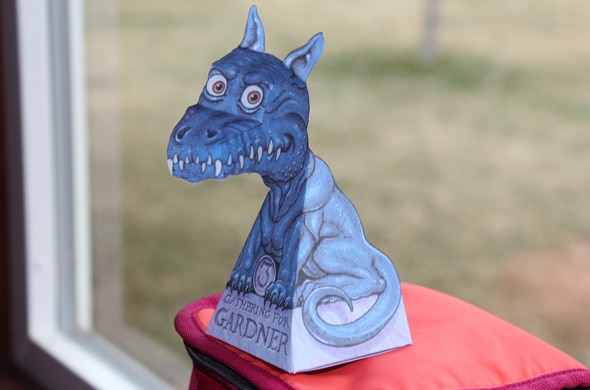Create a free profile to get unlimited access to exclusive videos, sweepstakes, and more!
Another Brain-Melting Illusion: The Dragon That Follows Your Gaze

I have another fun illusion for you today! Iâve received a lot of notes from folks pointing to a video showing a cutout Tyrannosaurus rex that seems to turn its head and follow you as you move. Itâs pretty good and based on a very similar illusion using a dragon. First, let me show you the T-rex, then my own video version of this with an explanation. Prepare to be creeped out â¦
Cool, eh? The video is by brusspup, who has recorded several other illusions (see Related Posts below). It was first created by master illusion-maker Jerry Andrus, in honor of skeptic and science/math writer Martin Gardner (I first saw it many years ago when I worked at Sonoma State University; my boss Lynn Cominsky had one sitting on her desk). Andrus used a dragon for the illusionâyou can see how similar the T-rex is to it in the photo above. I downloaded a paper version created by Binary Arts, cut it out, assembled it, and made this short video which explains what youâre seeing.
The key to this whole thing is the way your brain sees perspective, specifically convex and concave shapes, coupled with its uncanny ability to pick a face out of patterns (called pareidolia). Your brain wants to interpret the dragon as a face, and faces are convex: The sides of the face curve away from you (when you look at someoneâs face, their nose is closer to you than their ears).
But the dragonâs head is actually concave; the sides of the head curve toward you from the center. This sets up a contradiction in your brain; the cues you get as you move around the dragon get mixed up, and you think itâs turning to follow you. A big cue is in the eyes. The eye on the right (the dragonâs left eye) is below the left one in the cutout, and actually farther away from you. But your brain really wants to see a face, and if the face pops out, it must be facing a bit to the left, and therefore your brain thinks the eye on the right has to be closer to you. The same thing happens with the nostrils, the teeth, and the shape of the snout. All these cues are inverted, messing up the way your brain interprets their position in space.
I found that lighting and shading are critical to this making this work. Sometimes the illusion is obvious, and other times is hidden by the way light falls across the cutout (much like the âDune/Pitâ illusion). Even odder, the illusion is almost impossible to see with this dragon by eye, but on video itâs overwhelming. This is due to the loss of binocular vision (and therefore depth perception) when using a camera; when I close one eye and move around the dragon, the illusion is just as strong as in the video.
Anyway, this illusion is a version of the well-known âHollow Faceâ illusion. It also reminds me strongly of the âFloating Cubeâ illusion, which is so awesome Iâll include it here:
Man, I love that one. Freaky.
The dragon face is a pretty fun illusion, and itâs easy enough to make at home. Give it a try! Itâll be worth your time to play with. And of course, the lesson here is the same as it is with every illusion (and why, as a scientist and skeptic, I always hammer this home): Your eyes and brain are incredibly easy to fool. What you see is not always what you get.
One more thing: Many years ago I had the pleasure of meeting Andrus at a conference. I was unaware of who he was beforehand and got the impression of a brilliant if somewhat kooky older gentleman; he told us stories during lunch and it was a lovely way to spend an hour. It wasn't until later that I looked into his work and discovered what a genius he was at illusions. Do yourself a favor and look him up on the Web, including this video where he explains a few of his illusions. Trust me, you'll be delighted. Andrus died in 2007, and the world is a poorer place for it, but richer overall because he was in it.
Related Posts
The Magic of Physics: A Water Spiral
An Optical Illusion Youâll Swear Is Moving. It Isnât.
Viral Illusion Willâand ShouldâHave You Doubting Your Eyes
You Spin Me Right Round


























